What Are the Best Silent Headphones When Having a Baby
Considering style, safety, comfort, and functionality, here are the 8 best noise cancelling headphones for kids of all ages
| Name | Noise Reduction | Available for music listening? | Age Suitability | Price |
|---|---|---|---|---|
| PuroQuiets Best Overall | Active | Yes | 2 years old and up | BUY |
| JBL JR 460NC Strong Runner-Up | Active | Yes | 5 to 11 years old | BUY |
| PROHEAR 032 Best Budget | Passive | No | 3 years old and up | BUY |
| Dr.meter EM-100 Kids Ear Protection Best Ear Muffs | Passive | No | 5 to 11 years old | BUY |
| Snug Kids Ear Protection Best for Children with ASD | Passive | No | 2 to 7 years old | BUY |
| Alpine Muffy Baby Best for Infants | Passive | No | 3 months to 3 years old | BUY |
| SuperEQ S2 Best for Online Classes | Active | Yes | 3 years old and up | BUY |
| Sony MDR-ZX110NC Most Lightweight | Active | Yes | 9 to13 years old | BUY |
How to Pick the Best Noise-Cancelling Headphones for Kids
When it comes to our kids, it's instinctive to only want the best for them and to protect them in any way we possibly can. But amongst all the potential hazards out there, both known and unknown to us, damage to our children's hearing is one that is often underestimated.
Kids are naturally more sensitive to sounds, particularly because of their smaller ear canals and eardrums, and less-developed hearing. As such, prolonged exposure to loud sounds can lead to noise-induced hearing loss. What's even more worrisome is that by the time we figure out that something's amiss with our child's hearing, the damage is beyond repair.
Here come noise-cancelling headphones to the rescue!
However, when it comes to headphones, there are specific criteria that need to be met to pick out a great pair that your child will not only love and enjoy wearing but also protect them and support their productivity.
That's why, in this article, we listed the best noise-cancelling headphones that you can buy in 2021. Whether you're looking for ANC headphones to relax them on your next travel or aid them in their studies, we've got just the right selection for you.
But before that, let's guide you through the different factors we considered in our selection process, which can also help you come up with a final decision! Read on.
Noise reduction and hearing protection
Children are naturally more sensitive to sound because their smaller and narrower ear canals tend to amplify sounds to a greater degree.
Constant exposure to noise and other unnecessarily loud sounds doesn't just damage their hearing, they're also known to cause stress responses that can affect their health, impair cognitive development, and hamper concentration. In worse cases, some children can develop anxiety due to hyperacusis, a chronic condition identified by increased sensitivity to sound.
For these reasons, it's important to look for a noise reduction or noise cancellation feature in your child's headphones. A good pair of noise-canceling headphones or earmuffs can make all the difference when it comes to preserving their hearing and alleviating noise-related anxiety.
Noise reduction is achieved through two types of noise cancellation: active and passive.
- Passive noise cancellation (PNC) is the type typically found in ear protectors and earmuffs. These make use of thick padding materials like foam to create a physical barrier or seal over the ears. The effect is somewhat similar to sticking your fingers in your ears to block out noise. Most headphones already have a certain level of passive noise cancellation, but if you're on a tight budget, you can actually improve any headphones' noise isolation on your own.
- Active noise cancellation (ANC) uses advanced technology to cancel out noise. This sophisticated system works by taking an audio sample of existing background noise and creating an opposing frequency. The collision of these two opposing frequencies is what cancels out the unwanted noise.
ANC headphones don't usually come cheap though. Some can even go for around $1000, but these are mostly because of additional premium features. Most of these ANC headphones for kids are within a pretty low price range, though. And, similar to options for adults, ANC headphones under $100, you can expect just the right amount of noise cancellation without much higher-end ANC features in these headphones.
For more information about the differences between the two and, ultimately, choose which to go for, check out our comprehensive guide on passive vs. active noise cancellation.
Some headphones are also equipped with volume-limiting functions. This helps maintain the volume your child hears at a safe level (usually up to 85dB). Learn more about this in our detailed guide.
When it comes to earmuffs and ear protectors, a good way to determine how effective they are at blocking noise is by looking at their NRR or SNR for hearing protectors.
NRR (Noise Reduction Rating)
NRR is a unit of measurement used in North America that determines how effectively a device can reduce unwanted noise. The rating ranges from 0 to 30s. Essentially, if you're listening to something with a sound level of 90 dB, a 33 NRR-rated device can lessen than sound by up to 33 decibels. The higher the number is, the better protection you'll get.
SNR (Single Number Rating)
Like NRR, SNR also determines the noise reduction capacity of HPDs, though this rating system is more widely used in Europe. Similarly, a device with an SNR rating of 20 can reduce sound levels by 20 decibels. To make up for the inconsistencies of SNR ratings when applied to real-world settings, these also undergo the process of derating.
The recommended sound volume for children is around 80-85 dB, so you'll want to have a device with an NRR or SNR rating of at least 20 to keep them within the safe range.
It's important to note, however, that the NRR and SNR ratings aren't always accurate. This is because:
- Tests on hearing protection devices (HPDs) are often done in controlled environments and not in real-world settings.
- HPDs are sometimes worn incorrectly which affects their ability to reduce noise to the level specified in their rating.
To make up for these inconsistencies, the Occupational Safety and Health Administration (OSHA) and The National Institute for Occupational Safety and Health (NIOSH) have come up with their own "derating" processes that work to recalculate these ratings and reduce them to a more realistic number.
If you'd like to learn more about how NRR and SNR ratings are measured, we've written an in-depth article that breaks down those specifics right here.
Comfortable fit
Children, by their very nature, are more sensitive and easily distracted. As such, they're unlikely to endure long hours of feeling uncomfortable, especially if they're doing online classes and need to focus on a difficult or uninteresting lesson.
The bottom line is that kids will not tolerate an uncomfortable pair of headphones, regardless of what brand they are or how much they cost.
This is why choosing a pair of headphones that fit well is paramount when it comes to kids. Well-fitting headphones not only keep the discomfort away but also create a good seal over the ears which means that less noise travels into them. This also ensures that the ANC feature works more efficiently to block out background noise, thus aiding your child's concentration.
Here are a few other important comfort-related factors to consider when buying headphones for your kids:
Weight
When picking out a pair of headphones for a child, you'll want to consider the overall weight of the device.
The first headphones may have weighed for 10 pounds but, luckily, that's a thing of the past. Manufacturers have ensured better comfortability over the years with trying to keep headphones' weight under 1 pound. However, even 1 pounder headphones are now considered 'heavy'.
Ideally, kids' headphones should weigh no more than 0.5 lbs. You don't want a bulky pair of headphones weighing down heavily on their neck muscles and tiring them out, especially if they have to wear them for long periods of studying.
Adjustability
A comfortable pair of headphones should have some hardware adjustability. Because we're all built with different proportions, it's good to choose a pair of headphones that have an extendable headband and rotating ear cups to accommodate these differences.
Clamping force
The clamping force of headphones is what determines how snugly it fits around the head and ears. There's no "standard" amount of clamping force as this varies depending on the manufacturer and how the headphones are engineered. Ideally, however, the clamping force should deliver an equal amount of pressure on all contact points.
You'll also want a clamping force that's firm enough to keep the headphones stabilized and give the ears a good seal. If they're too loose, they risk falling off if your child moves around a lot. Loose headphones also defeat the purpose of noise cancellation. If they're too tight, on the other hand, they can get quite painful on the temples and ears after a few minutes.
We know how painfully uncomfortable it can be to wear too-tight headphones over glasses, so if your child wears glasses, make sure to have them try on different pairs before settling on one.
Padding and materials
Earcup padding works as a cushion between our ears and the headphone hardware. The materials vary between manufacturers but usually include memory foam, silicon, pleather, leather, or velour.
Memory foam and velour are known to be more flexible, breathable, and soft, making them easy to wear for long periods. Leather and pleather, on the other hand, tend to feel firmer on the ears and can get quite warm from our body heat, eventually making our ears feel stifled after some time. This is important especially if your child will be wearing the headphones for a few hours.
Earcup size
Headphone ear cups come in different sizes, with variations in width and depth. Since children have smaller ears, it's important to pay attention to how small, large, or shallow the earcups are. Ear cups that are too small or shallow may make the ears feel cramped, and if they're too big, they may not create a good seal for the ears, defeating the purpose of noise cancellation.
Fit type
Common fit types for headphones are over-ear and on-ear. Over-ear headphones have ear cups that are circular, oval, or D-shaped. They're bulkier and cover the entire ear, making them quite comfortable and good for noise isolation
On-ear headphones, on the other hand, typically have small circular ear cups that rest over the ear and don't cover them completely. These types are more lightweight and allow better air circulation around the ears. They do, however, experience more sound leakage in comparison to over-ear headphones and can cause pressure on the ear after some time.
Aesthetics
Bright colors and fun designs are often of greater importance to children than any of the technical stuff that preoccupies us grown-ups. In addition to being a vehicle for self-expression, colors are also known to have positive psychological effects on children related to boosting their mood and emotions.
Build Quality
Kids will be kids, and they can be excitable, careless, and rough. They're less likely to be gentle with their belongings and the chance of them breaking a new device in a short amount of time is high. To save you money, time, and stress, make sure to choose headphones with a significant amount of durability.
- Material durability: Materials have to delicately balance between comfort and durability. While most headphones for kids are made of plastic due to plastic's light weight, moving parts (i.e. the sliding hinges in the headband) should be made of more durable metal like steel or aluminum.
- Product reviews: Take advantage of the sometimes thousands of Amazon reviews of any pair of headphones before purchasing to get an idea of the experience users have with these headphones. Also, consider watching YouTube reviews and reading individual's reviews to get a deeper look.
Unboxing videos can give you a good idea of packaging quality, while long-term use reviews will give you a better idea of how the headphones perform over time.
- Warranty: Headphones typically come with the standard 1-year warranty. However, a longer warranty doesn't just give better coverage. It also demonstrates the manufacturer's confidence in the sturdiness of their product.
8 Best Noise-Canceling Headphones for Kids [2021]
Here are our choices for the best noise-canceling headphones suitable for kids:
PuroQuiets
Best Overall
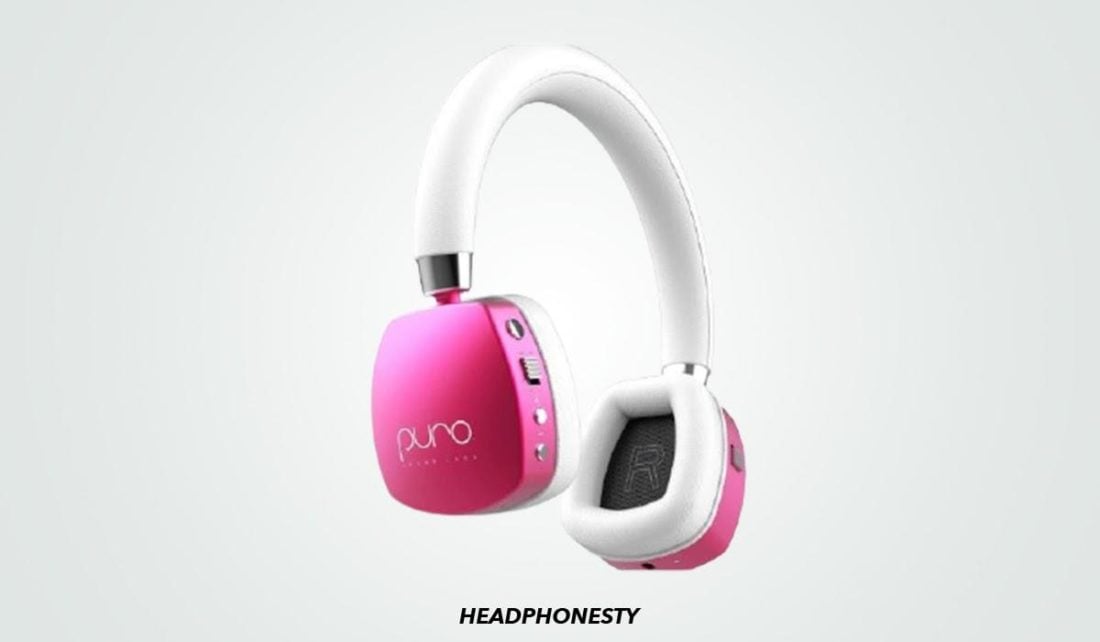
Key features
- Form Factor: On-ear
- Noise Reduction: -22 dB via Active Noise Cancellation (ANC)
- Can play music: Y
- Volume Limit: 85dB
- Weight: 0.36 lbs
- Battery Life: 23 hours w/ ANC & 35 hours without
- Best for: 2 yrs old and up
- Other features: Bluetooth 5.0 wireless function, cVc 8.0 microphone for clearer calls, aluminum casing, and leather padding
After Puro Sound Labs founder, Dave Russell, discovered his daughter was suffering from noise-induced hearing loss (NIHL), he set about creating a solution that would hopefully prevent other kids from experiencing the same thing.
One of the many results of this effort is PuroQuiets headphones for kids, designed to lessen noise exposure damage with the help of a volume limiter and active noise cancellation technology.
The PuroQuiets are fitted with active noise cancellation that reduces the sound of unwanted background noise by up to 78% to protect your child's sensitive ears. It also comes with a volume-limiting function that keeps the audio levels at a safe 85 dB and cannot be bypassed. These make sure your child won't be able to push the volume levels any further than what's advisable and prevent noise-induced hearing loss.
For hours of comfortable playtime, the lithium-ion battery has a capacity of 200 standby hours, 23 hours of listening with active noise cancellation, and 35 hours without, which should last your child several days even if they forget to recharge the device. The headphones also come with a 3.5mm audio cable that can be used for listening in case the battery runs out and there's no time to charge it.
Comfort is also factored in with the PuroQuiets. The on-ear ear cups and adjustable headband are both outfitted with soft protein leather padding, making them extra comfortable for children even after extended use.
The PuroQuiets are equipped with Bluetooth 5.0 with a connectivity range of 32 feet. It's great for freedom of movement and lessens the likelihood of accidents, like your child snagging or tripping on the wires. The headphones are also outfitted with a solid aluminum casing to keep their complex internal mechanisms safe if dropped or mishandled.
The buttons for toggling the power, volume, and active noise cancellation are easy to use as they are clearly labeled and easily accessed at the sides of the earcups, so even small children can understand and operate them.
While the PuroQuiets gets good marks in noise cancellation and sound quality, a common issue that users seem to have with the device has to do with a too-tight fit that sometimes makes wearing them uncomfortable. This, however, can be expected of brand new headphones right out of the box and can be mitigated with regular use and stretching the headband out a bit.
The headphones also use a micro-USB cable for charging, which can only be plugged in a specific way. This might prove to be a challenge for small, eager fingers. It should, however, be alleviated with careful guidance and instruction.
CHECK LATEST PRICE ON AMAZON
JBL JR 460NC
Strong Runner-Up
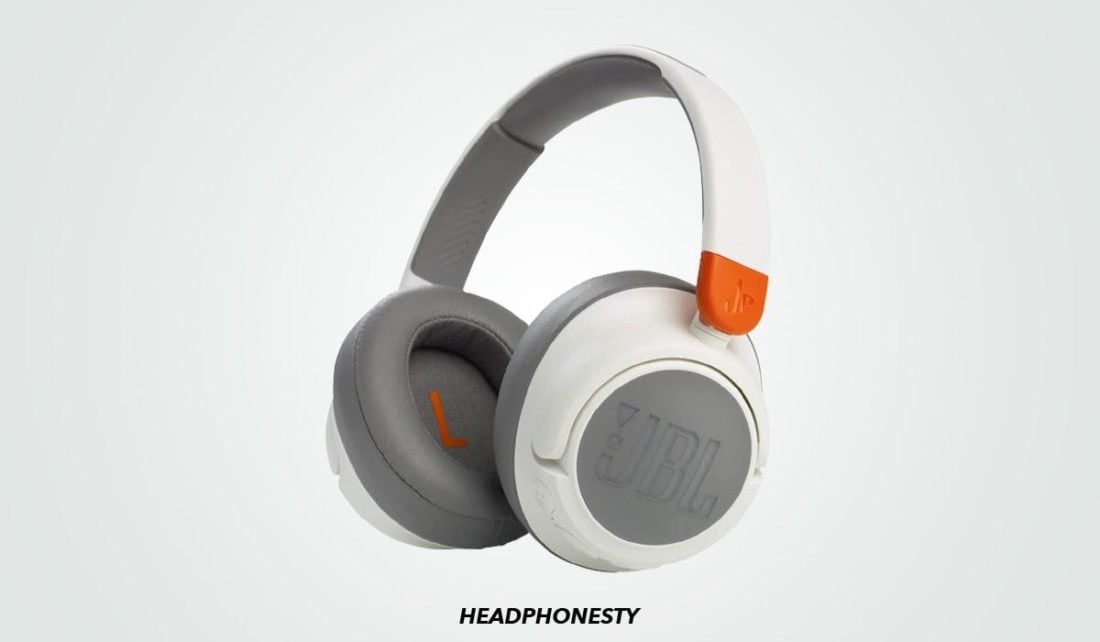
Key features
- Form Factor: Over-ear
- Noise Reduction: Active Noise Cancellation – 18 dB
- Can play music: Y
- Volume Limit: 85dB
- Weight: 0.44 lbs
- Battery Life: up to 20 hours of Bluetooth playtime and 30H with ANC off
- Best for: 5-11 years old
- Other features: Built-in mic, 2 hour quick charge, detachable audio cable, Bluetooth connectivity
The JBL Jr 460NC headphones are great for young people with varied interests and needs, such as gaming, listening to music, and studying. Their expansive features give them a great all-around feel.
For gamers, they come with a built-in mic and lengthy battery life, great for long weekend play sessions. Bluetooth connectivity can also be popular with children into mobile and tablet gaming.
The JBL Jr 460s also come with a detachable audio cable, allowing them to play music from virtually any source. Moreover, the materials, while lightweight and soft, are also break and tear-resistant – great for kids who get excited and play around during exercise-heavy jams.
Whether it is the now quintessential lofi beats or a bit of Bach, these headphones cancel out up to 18dB of noise to encourage immersion into study time. Just enough to block out the humming of a fan and dull the barking of the neighbor's dog without granting a free "ignore mom" excuse.
In a world where parents have begun to love online classes, the JBL Jr 460's features make for a solid fit. The 20 hours of battery life with Bluetooth (and up to 30 without) allows for two full days of classes with an extra two hours for quiet study time even if the student forgets to charge them overnight.
Extended listening can harm children's ears. That is why there are safety locks in place for the JBL Jr. 460 headphones that keep their volume at less than 85 dB. Combined with all other described features, this makes them the ideal remote classroom noise cancelling headphones for kids.
They come in two color schemes, "blue" and "white". The blue is a light and dark blue plus neon green highlight combo, especially appealing to boys 9 and under. Meanwhile, the white combines white, grey, and orange to give a smart and robotic feel, as if it were inspired by Valve's Portal .
Unfortunately, these headphones lacks a bit when it comes to the overall noise cancellation, especially when compared to the rest of the list. While it efficiently blocks out lows and mids, and can be extra useful in cancelling the engine noise of an airplane, they won't be much useful in blocking out nearby chatters.
CHECK THE LATEST PRICE ON AMAZON
PROHEAR 032
Best Budget
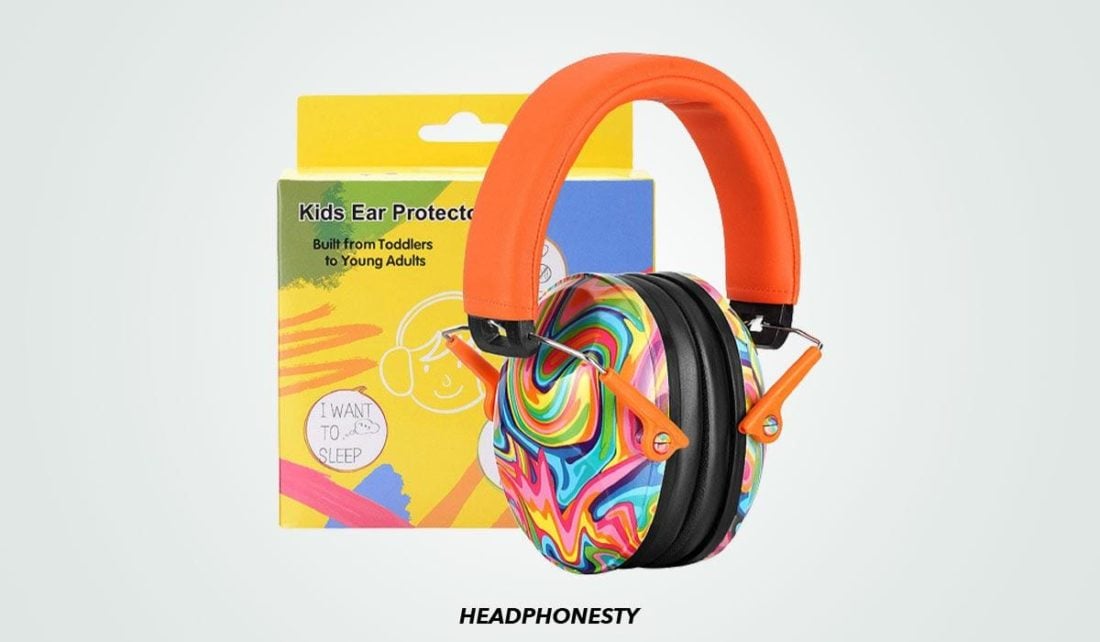
Key features
- Form Factor: Over-ear
- Noise Reduction: NRR – 25 dB / SNR – 29 dB
- Can play music: No
- Volume Limit: N/A
- Weight: 0.39 lbs
- Battery Life: N/A
- Best for: 3+ years old
- Other features: ANSI S3.19 and CE EN 352.1 safety certifications, made from ABS Plastics + foam
The PROHEAR 032 is a lightweight and portable solution for hearing protection in any environment. It's designed for toddlers and older children and comes in colorful designs that appeal to all ages.
These passive noise-canceling headphones can reduce noise up to 25 dB and have met the noise reduction standards of ANSI S3.19 and CE EN 352.1. They're good for limiting audible distractions when your child needs to concentrate on studying and great for loud outdoor activities like fireworks shows, sporting events, carnivals, and the like.
The headphones are made from ABS plastic and are lightweight weighing at only 6.9oz. The over-ear earcups are outfitted with deep foam earpads and leather, providing maximum comfort for your child even after prolonged use.
Aside from the adjustable headband length and 360-degree rotatable earcups, the earpads can also be easily replaced by simply pulling out the pads and snapping a new one in place.
The PROHEAR 032 comes in three fantastically vivid colors and patterns, crafted so they don't fade over time. Not only are they sure to grab the attention of both younger and older kids, but their high visibility design also makes it easy to keep tabs on your kids in any crowded setting or weather condition.
A true space-saver, these headphones can be folded into a more compact size and stowed away in the travel drawstring bag it comes with. It can easily fit into smaller child-friendly spaces that your kids have easy access to.
Despite the great features, the headphones can be difficult for kids to adjust. Also, they can be too tight for kids with larger heads, which can be the case for brand new headphones. A way to alleviate this is to stretch the headphones over the packing box and leave it overnight.
CHECK LATEST PRICE ON AMAZON
Dr.meter EM-100 Kids Ear Protection
Best Ear Muffs
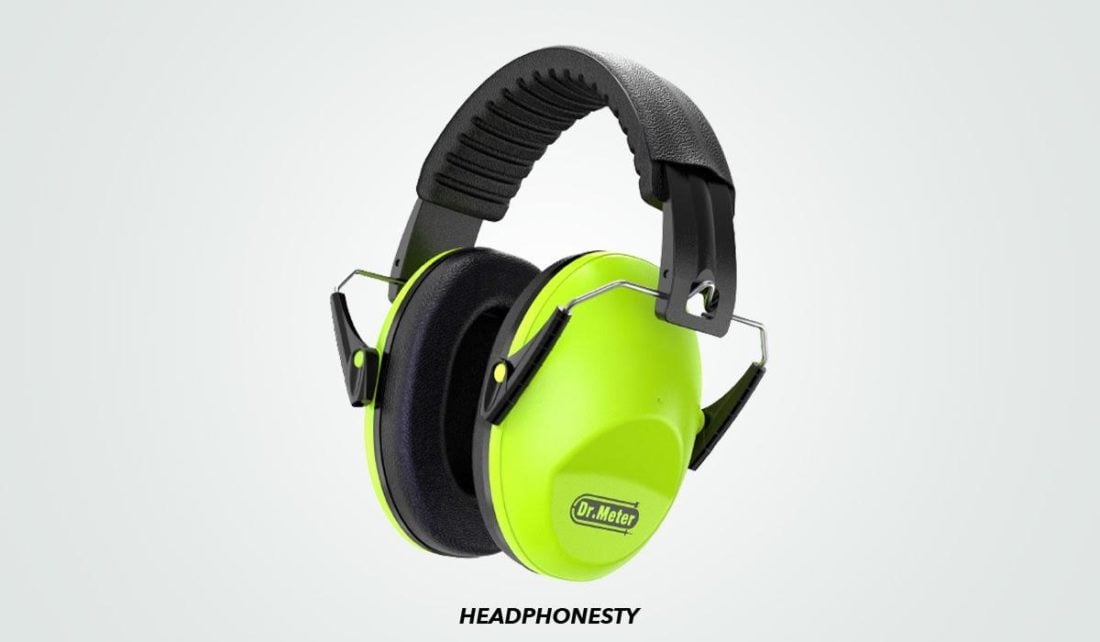
Key features
- Form Factor: Over-ear
- Noise Reduction: NRR – 27 dB / SNR – 30 dB
- Can play music: No
- Volume Limit: N/A
- Weight: 0.43 lbs
- Battery Life: N/A
- Best for: 5-11 years old
- Other features: ANSI S3.19 and CE EN 352.1 safety certifications, PU leather headband
The Dr.meter EM-100 Kids Ear Protection headphones provide professional noise reduction adapted specifically for the smaller ears of children and babies.
The headphones are equipped with passive noise cancellation and the high-density sponge padding inside the earcups reduces unwanted noise up to 27dB. It's also both ANSI S3.19 and CE EN 352.1 approved, making it ideal for children attending loud live outdoor events or helping with home improvement activities.
The headband and earcups are made from soft, high-density PU leather that allows for better heat dissipation. Adjustability is no problem because the earcups can be rotated 360 degrees and the adjustable pins allow the headband to be lengthened or shortened to suit kids of all ages. The headphones' low clamping force also makes it comfortable to wear for long periods.
However, the headphones can be tricky for children to handle or wear, since they're designed to spring back into a folded position. There are also issues concerning build quality and durability with some users experiencing their brand new headphones breaking down after a short period of use.
CHECK LATEST PRICE ON AMAZON
Snug Kids Ear Protection
Best for Children with ASD
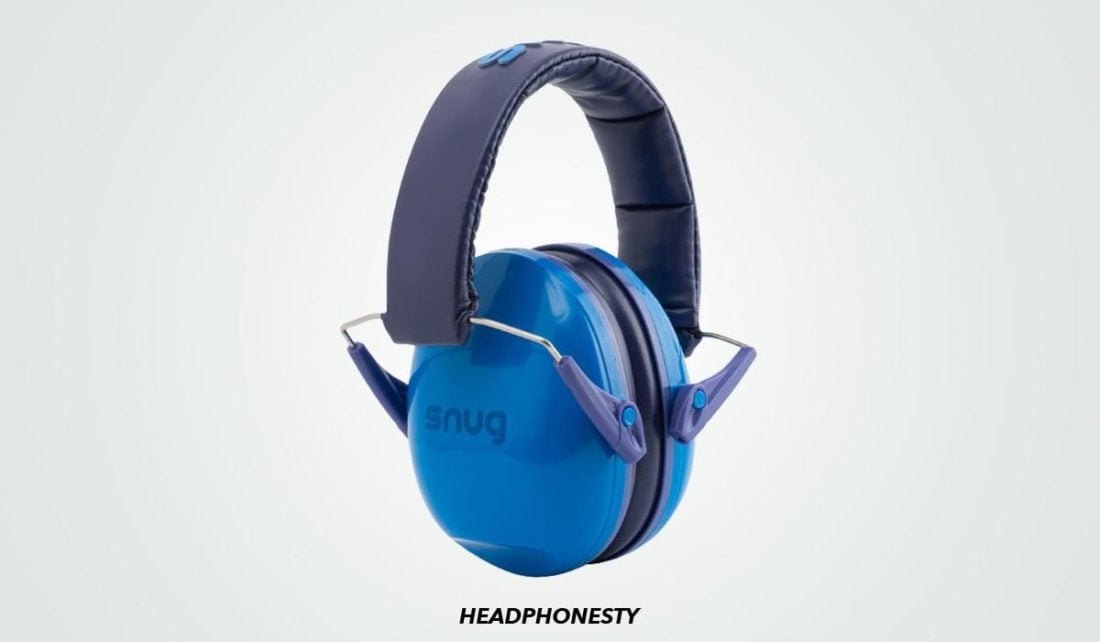
Key features
- Form Factor: Over-ear
- Noise Reduction: NRR – 25 dB
- Can play music: No
- Volume Limit: N/A
- Weight: 0.39 lbs
- Battery Life: N/A
- Best for: 2-11 years old
- Other features: Overstimulation reduction for ASD children.
The Snug Kids Ear Protection headphones offer the very best for active children with Autism Spectrum Disorders (ASD). The lightweight, over-ear frame ensures a snug fit for everyone.
One in 68 children in the US have an ASD. If you're a parent that doesn't have a child with an ASD, you're likely to have a friend in your parenting group who does. The Snug Kids line was created, in part, for these children.
Loud activities from other household members, such as vacuum cleaning or woodworking, can cause distress and sensory overload in some ASD spectrum children. The impressive 25 dB NRR of the Snug Kids headphones can help protect against that constant irritation. This quieter state gives the child a chance to pause and regroup, reducing stress.
The comfortable foam padding around the ear cups also allows for the tight seal to block out noise.
The headphones come in a wide variety of colors: blue, baby blue, yellow, red, purple, green, navy, and pink. Special hinges allow the headphones to collapse down to a roughly spherical shape the size of a baseball that can be tossed in your child's backpack.
Moreover, the designs don't stop at just colors. There are pairs of Snug Kids sporting unicorns, dinosaurs, pineapple people, stylish cats, automobiles, and more.
These headphones are also some of the most durable pairs for kids. Don't believe you can just 'toss' the headphones in your bag? Snug Kids' creator does! The Snug Kids line comes with a 5 year guarantee due to the strong, durable parts in them.
Even though these are advertised to be good for 2 to 11-year-olds. the clamping force may not be too comfortable for older children.
CHECK LATEST PRICE ON AMAZON
Alpine Muffy Baby
Best for Infants
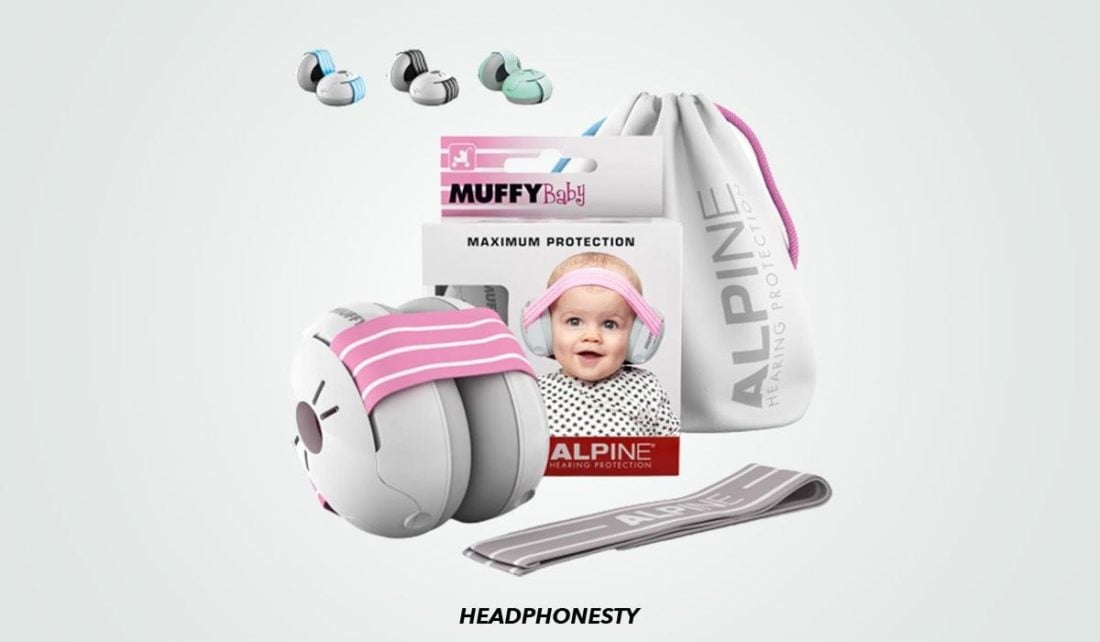
Key features
- Form Factor: On ear
- Noise Reduction: NRR – 22 dB
- Can play music: No
- Volume Limit: N/A
- Weight: 0.37 lbs
- Battery Life: N/A
- Best for: 3 months – 3 years old
- Other features: BPA free (made from ABS, PVC+PU, polyester), CE-certification, special washable soft headband, travel bag included
The Alpine Muffy Baby headphones are designed specifically for your toddler, packed with a ton of safety features. They come in baby blue, pink, and gender-neutral black.
The headphones are made without BPA, a chemical that can cause developmental difficulties in children under the age of two. Instead, the Alpine Muffy Baby's use ABS for the cover, PVC+Polyurethane leather for the padding, and polyester for the special headband.
Potential side effects of overexposure to BPA in infants can include abnormal growth of the brain and prostate gland, among other problems.
The polyester headband, somewhat resembling a seatbelt, is completely soft and rests lightly across the baby's forehead. This supports the fontanel (aka 'soft spot'), which isn't fully formed until babies reach 18 months old. The headband is also washable and all sets come with a spare.
With all of these features, it is no wonder that the Alpine Muffy Baby is the only hearing protection with a CE-mark on the market. With all of this attention to safety, the question must be asked: Do babies really need noise cancelling headphones?
Hearing loss before the age of 18 months can have lifelong repercussions, including garbled speech and delayed language acquisition.
Like most questions about child rearing, the answer is 'it depends'. If you're going into loud areas for extended periods of time it is absolutely worth the extra protection – especially at the affordable price point offered by Alpine Muffy Baby.
Now while these are great options, do keep in mind that fidgety, bouncy babies are known to cause the Alpine Muffy Baby's headband to slide down the forehead, covering the child's eyes.
CHECK LATEST PRICE ON AMAZON
SuperEQ S2
Best for Online Classes
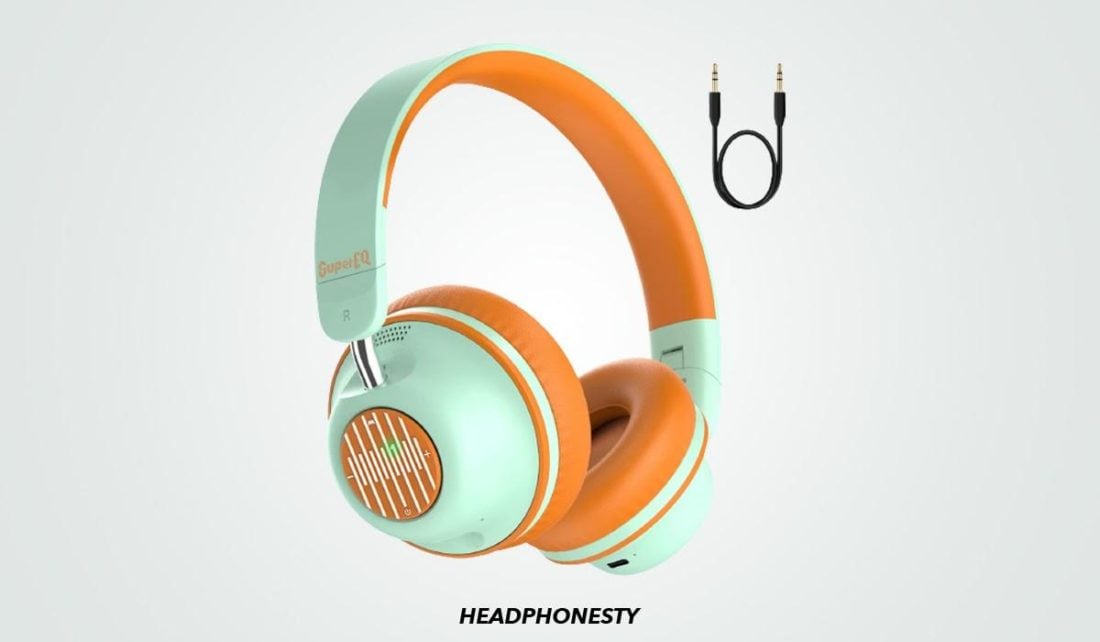
Key features
- Form Factor: On ear
- Noise Reduction: Active Noise Cancellation – 25 dB
- Can play music: Yes
- Volume Limit: N/A
- Weight: 0.46 lbs
- Battery Life: 45 hours (wired noise-canceling mode), 25 hours (Bluetooth mode), 18 hours (Bluetooth noise-canceling mode)
- Best for: 3 years old and up
- Other features: Memory foam ear cups, built-in CVC 8.0 noise-reduction mic, 40mm Neodymium magnet drivers for hi-fi sound, supports Bluetooth and 3.5mm aux cable, airplane adapter included
The SuperEQ S2 headphones bring style and noise-cancellation for kids of any age (even up to "college kid") at a suitable price. With a lot of great color templates to choose from plus functional features, these headphones are great for the back to online classes student.
Memory foam protein ear cups will help reduce tension on the student's ears as the hours in class pass by. In combination with the under half pound weight, the headphones will slowly become unnoticeable even after a whole day of classes.
These also have a CVC 8.0 noise-reduction mic built right into the ear cup. This, along with 25dB of ANC, allows students to forget their surroundings and focus on their classes.
It's no longer news that clothes affect performance, so getting a headset that really grooves with a student's style is important. The orange-green style has a delightful future retroism aesthetic, the classic black appears sleek and smart, while the black-green gives off subterranean wonderland vibes.
But what about after class? The SuperEQ S2s have Neodymium magnet drivers for hi-fi listening and are fitted with a Qualcomm QCC 3003 chip for the highest quality in wireless streaming. The 3.5mm aux cable adapter increases the possibilities even more. They also come with an IPX4 rating, making them great even for kids who easily sweat.
The only downside is the ANC control button is a bit small and wearers with larger fingers may find themselves fiddling with it while getting used to the headphones.
CHECK LATEST PRICE ON AMAZON
Sony MDR-ZX110NC
Most Lightweight
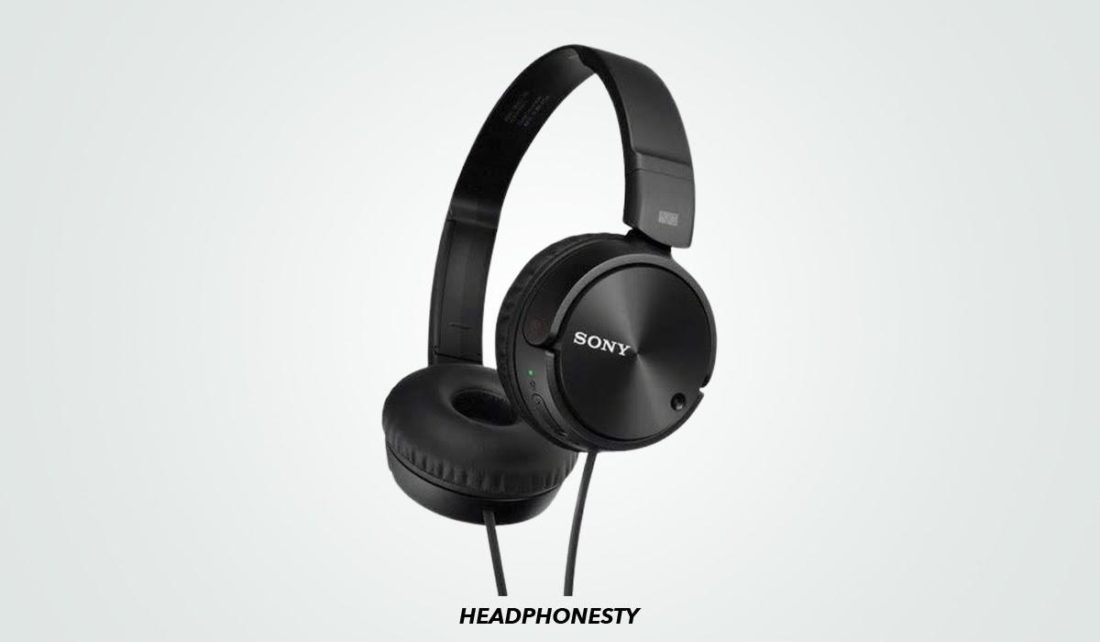
Key features
- Form Factor: Over-ear
- Noise Reduction: Active Noise Cancellation (≥13 dB)
- Can play music: Yes
- Volume Limit: N/A
- Weight: 0.33 lbs
- Battery Life: 80 hours playtime (w/ LR03 alkaline battery), 40 hours (w/R03 manganese battery)
- Best for: 9-13 years old
- Other features: L-shaped plug, all-plastic design
The Sony MDR-ZX110NC is a budget-friendly device that provides battery-operated active noise cancellation encompassed in a simple, sleek, all-black design.
The active noise cancellation have12–22,000 Hz frequency response to ensure you're getting crisp audio quality. Together, as much as 95% of unwanted noise is lessened, eliminating the need to turn up the volume to levels that could damage your child's hearing.
These wired headphones function on a single AAA battery, but the length of playtime varies depending on the type of battery used.
R03 manganese batteries will get you 40 hours of playtime, but kids can get more out of LR03 alkaline batteries, which yield a whopping 80 hours of listening time.
This extended battery life also proves that this pair of ANC headphones can be a great option for studying. It can make sure your kids won't lose their focus or interrupt their studies just to charge their headphones. This is why Sony MDR-ZX110NC is awarded the "best battery life" in our list of the best ANC headphones under $50.
Weighing at 0.33 lbs, the Sony MDRZX110NC is the lightest pair of headphones on this list of recommendations. The all-plastic design includes the standard adjustable headband, rotatable on-ear earcups, and leather earpads with a smaller opening better suited for children's' ears.
The headphones also feature an L-shaped audio plug, which lessens the likelihood of the plug getting bent out of shape due to rough or careless handling.
Additionally, kids nowadays sometimes lean more on virtual games rather than physical activities. Fortunately, these headphones' 3.5mm connection makes them compatible with different gaming platforms. This means this can also serve well as noise-canceling gaming headphones for little kids.
The Sony MDR-ZX110NC are great for having decent sound quality, however, the same cannot be said for their below-average build quality, which makes the headphones feel cheap when handled. The flimsy cables can leave the audio wiring exposed after a few months' use, while the battery cover are prone to coming apart.
CHECK LATEST PRICE ON AMAZON
Conclusion
Choosing a good pair of noise-canceling headphones can make all the difference when it comes to preserving your child's hearing. But more than that, they can also help them focus on schoolwork longer, keep them safe at noisy outdoor events, and lessen the anxiety that disruptive noises can sometimes cause.
Hopefully, this detailed guide has helped you to make a more informed choice for your family. Just remember to keep those key buying factors in mind: comfort, aesthetics, and durability.
However, if you're looking for ANC headphones for you or your more grown-up kids, you can check out our list of the best noise cancelling headphones for every category. It has all the best options you can get for ANC headphones from the most affordable prices, to mid-range options, and industry leading ones.
How did you find our recommendation list? Think we missed out on some great devices or want to share your suggestions? We'd love to hear them, so just sound off in the comments sections below!
What Are the Best Silent Headphones When Having a Baby
Source: https://www.headphonesty.com/2020/10/best-noise-cancelling-headphones-for-kids/
0 Response to "What Are the Best Silent Headphones When Having a Baby"
Post a Comment